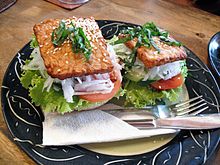- Meat analogue
-
 Hong Kong style tofu from Buddhist cuisine is prepared to have a texture similar to meat.
Hong Kong style tofu from Buddhist cuisine is prepared to have a texture similar to meat.
 Tempeh Burger
Tempeh Burger
A meat analogue, also called a meat substitute, mock meat, faux meat, or imitation meat, approximates the aesthetic qualities (primarily texture, flavor, and appearance) and/or chemical characteristics of specific types of meat. Many analogues are soy-based (see: tofu, tempeh).
Generally, meat analogue is understood to mean a food made from non-meats, sometimes without other animal products such as dairy. The market for meat imitations includes vegetarians, vegans, non-vegetarians seeking to reduce their meat consumption for health or ethical reasons, and people following religious dietary laws, such as Kashrut or Halal. Hindu cuisine features the oldest known use of meat analogues.
Meat analogue may also refer to a meat-based and/or less-expensive alternative to a particular meat product, such as surimi.
Contents
Vegetarian meat, dairy, and egg analogues
 Veggie burgers garnished with onion, ketchup, and Cheddar cheese.
Veggie burgers garnished with onion, ketchup, and Cheddar cheese.
Some vegetarian meat analogues are based on centuries-old recipes for seitan (wheat gluten), rice, mushrooms, legumes, tempeh, or pressed-tofu, with flavoring added to make the finished product taste like chicken, beef, lamb, ham, sausage, seafood, etc. Yuba is another soy-based meat analogue, made by layering the thin skin which forms on top of boiled soy milk.[1] Some more recent meat analogues include textured vegetable protein (TVP), which is a dry bulk commodity derived from soy, soy concentrate, mycoprotein-based Quorn which uses egg white as a binder making them unsuitable for vegans, and modified defatted peanut flour.
Dairy analogues may be composed of processed rice, soy (tofu, soymilk, soy protein isolate), almond, cashew, gluten (such as with the first non-dairy creamers), nutritional yeast, or a combination of these, as well as flavoring to make it taste like milk, cheeses, yogurt, mayonnaise, ice cream, cream cheese, sour cream, whipped cream, buttermilk, rarebit, or butter. Many dairy analogues contain casein, which is extracted dried milk proteins, making them unsuitable for vegans.
Egg substitutes may be composed of tofu, tapioca starch, or similar products that recreate the leavening and binding effects of eggs in baked goods. Many people use fruit products such as banana paste or applesauce as egg analogues in baking.
Lab-grown animal tissue
Main article: In vitro meatBiologists have long researched methods for growing muscle tissue in laboratory conditions, and the technology is ready for commercial use.[citation needed] PETA has offered a $1 million prize to the first company that can bring lab-grown chicken meat to consumers by 2012.[2]
Surimi and similar meat-based meat analogues
Surimi, a processed hash of fish plus flavorings, is used to make products such as imitation crab meat. In some regions,[where?] "surimi" refers only to products made from fish, but elsewhere[where?] may refer to other products (e.g., turkey dogs produced from turkey in North America), which are then also called "surimi".[by whom?]
Examples of surimi include:
- Surimi from fish, such as imitation crab, imitation shrimp, or imitation lobster
- Surimi from turkey, such as hot dogs, brats, sausage, salami, lunch meats, loafs, burgers, bacon, ham, or ground
- Other processed poultry products, such as emu, in the same forms described above for turkey.
Surimi products are often marketed as "imitation" meats (e.g., "imitation crab meat", "imitation shrimp").
Literature
- Wyrick, Jason (2009-03). "Meat Subs". Vegan Culinary Experience. http://veganculinaryexperience.com/VCEMarch09.pdf. Retrieved 2011-04-15.
Notes
- ^ Patterson, Daniel. The Way We Eat: I Can't Believe It's Tofu, New York Times, 2006-08-06. Retrieved on 2009-02-26.
- ^ http://www.npr.org/templates/story/story.php?storyId=90235492
External links
- Business statistics - sales of imitation meat and vegetarian products
- Research Market: vegetarian profits
- Soyfoods Assoc. of N. America
- Meat-analogues on "FutureFood - Meat without livestock"
Categories:- Meat substitutes
- Buddhist cuisine
- Imitation foods
Wikimedia Foundation. 2010.

